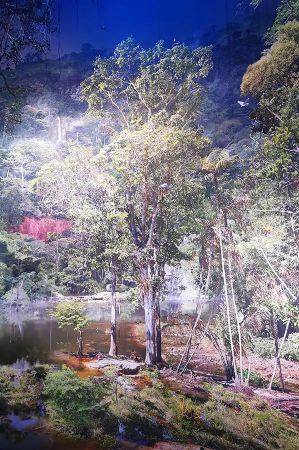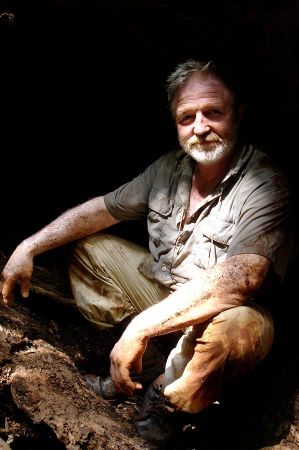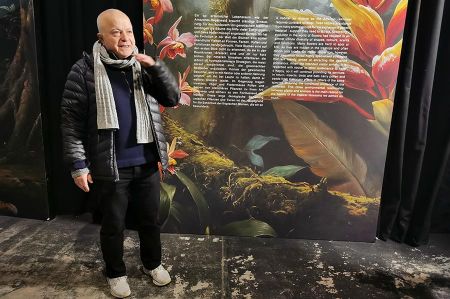Amazonia by Yadegar Asisi – Fascination of tropical rainforest
- Written by Portal Editor
Shortly before the official opening of the large panorama in the Dresden Panometer, we were also invited guests of the photographer, painter and architect Yadegar Asisi, who was born and raised in Vienna in 1955, then studied architecture in Dresden and painting at the University of the Arts in Berlin.
Since 2003, Asisi has been creating monumental 360° panoramas with a size of up to 3,400 square meters, mainly in old gasometers that have corresponding eaves heights of 30 or more meters.
360° panoramas of various locations

The natural panorama of the Amazon can therefore also be seen as a homage to all the naturalists who have explored the rainforest: First and foremost, Alexander von Humboldt, who travelled to the Amazon region at the beginning of the 19th century. So, it's no wonder that Yadegar Asisi began our meeting in the Panometer with Humboldt's portrait.
Dr. George McGavin – Doctor of Entomology at Imperial College

Never before had we seen such an extensive collection of insects and their function and importance in biodiversity, which were explained to us in detail and personally during our numerous visits. George was also a lecturer at Trinity College and then at Jesus College.
After a 30-year academic career, he then became a television presenter, working mainly for productions at the BBC Natural History Unit in Bristol. But more on that later.
Press conference in the Dresden Panometer
He took tens of thousands of photographs and countless sketches, watercolours and drawings, which he used for the 360° panorama.
In the tropical rainforest, plants grow both extremely close together and in a specific vertical order, which is known as stratification or storey structure.
Easy to follow in the large panorama, as the visitor tower alone gives the impression of different viewing positions in height.
- the soil layer, consisting of the roots of the plants and a usually very thin layer of humus
- the herb layer, which can include, for example, mosses, ferns and other ground cover plants that require very little light
- the shrub layer up to a height of approx. 5 m, which also includes young trees
- the layer of low trees
- the crown layer with its main canopy at a height of approx. 40 m
- the so-called jungle giants known as “tree giants” which occasionally protrude up to a height of approx. 60 m above the main canopy
- Flat, wide-spreading root system made of powerful buttress roots in the Brazilian rainforest
The epiphytes use the stronger light in the upper regions
The epiphytes use the stronger light in the upper regions of the trees. Since there is a lack of water and nutrients at altitude, they use so-called niche leaves to form cavities in which humus is created and water is collected. Many bromeliads use their leaves to form cisterns in which water collects. This water is absorbed via the leaf surface with the help of special absorption organs (suction scales).
The fauna of the tropical rainforests is also characterized by an extraordinarily high level of biodiversity. By far the largest proportion is made up of arthropods - i.e. insects, arachnids, millipedes and crustaceans. Over time, natural selection led to an ever-better adaptation of the fauna to the ecological conditions of the rainforest. For example, the strikingly coloured tree climbing frogs of Central and South America spend their entire lives in the treetops - their spawn develops in the puddles of bromeliad leaves. Like many other rainforest amphibians, they are very poisonous.
Rainforest birds have strikingly colourful plumage
The large panorama, now opened by Yadegar Asisi, takes visitors on a journey of discovery through the tropical rainforest. As if in a clearing, the view opens wide into the Amazon landscape - onto the impressive treetops with up to 10-meter-high buttress roots, onto fascinating plants and animals, from the poisonous strawberry frog and mud-licking butterfly to the elegant jaguar and the artistic climbing ocelot. Through the day and night simulation, visitors can “experience” several “days” in the Amazon and enjoy the incomparable beauty and enormous biodiversity of the tropical rainforest in an immersive way.
Hopefully humanity can preserve this natural phenomenon!
Please read as well:
Amazonia in the Panometer of Dresden – Yadegar Asisi
Oranges and blood oranges – vitamins in winter
-
-
-
-
-
-
-
-
-
-
-
-
https://www.alaturka.info/en/life/fauna/6508-amazonia-by-yadegar-asisi-fascination-of-tropical-rainforest/amp#sigProIdd867947739
